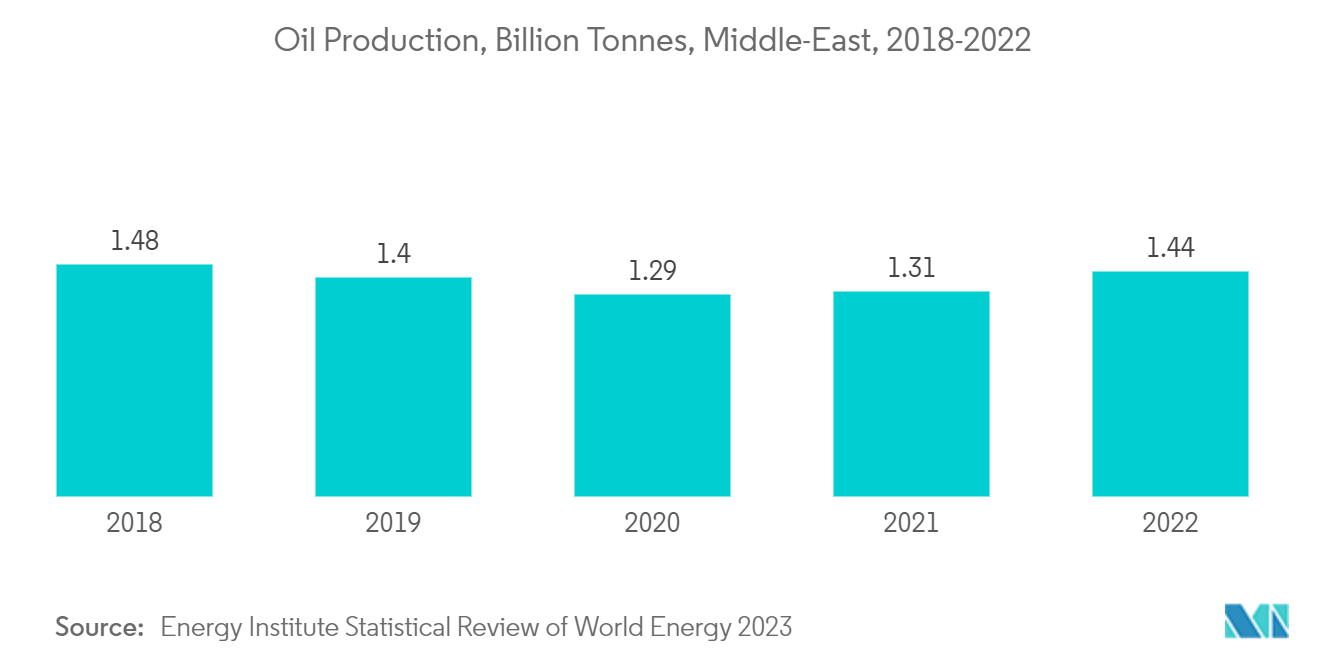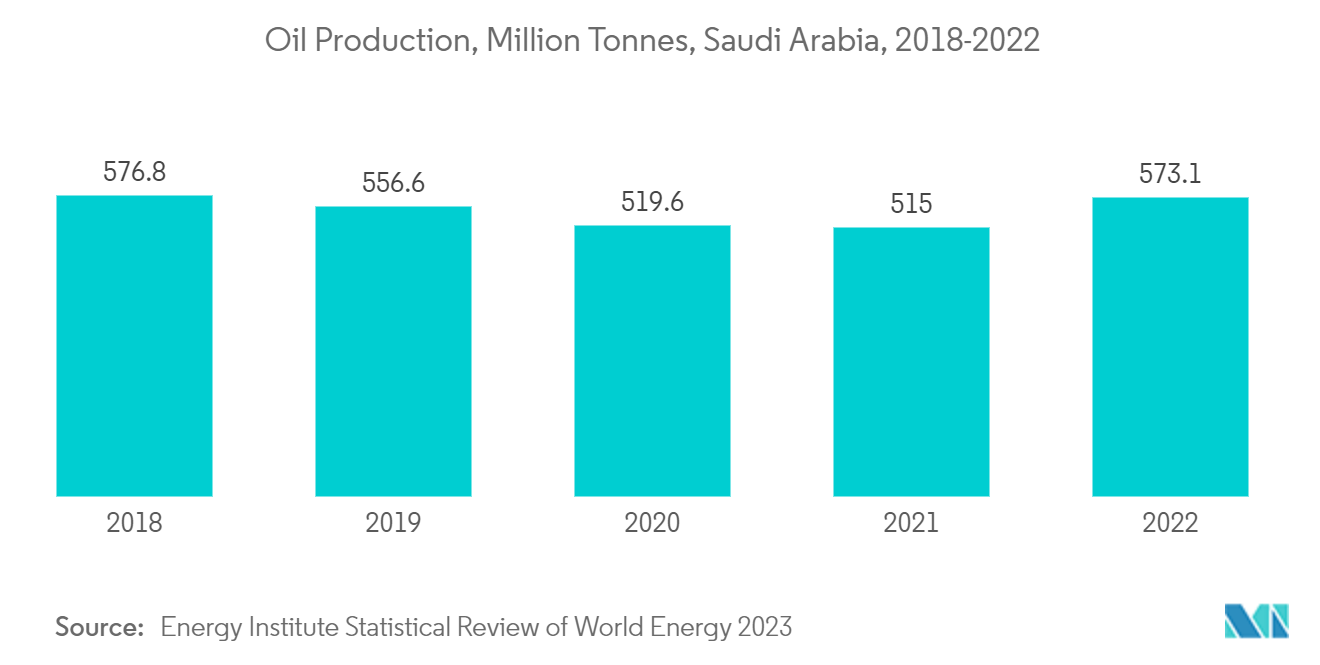Market Trends of Middle-East Industrial Gases Industry
Oil and Gas Industry to Dominate the Market
- Nitrogen and carbon dioxide are the two most common industrial gases used in upstream oil and gas activities. Nitrogen and carbon dioxide as bulk gases are used in huge quantities to extract and explore oil and natural gas with induced hydraulic fracturing, commonly known as fracking.
- Nitrogen is utilized in the drilling, workover, and completion phases of oil and gas wells and in pipeline pigging and purging. Nitrogen applications include well stimulation, injection and pressure testing, enhanced oil recovery (EOR), reservoir pressure maintenance, nitrogen floods, and inert gas lift, and it is used in both onshore and offshore applications.
- Carbon dioxide(CO2) is applied to a reservoir as a tertiary oil recovery method. CO2 services are also used for energized fluid fracturing (fracking) in conventional reservoirs for long-reach horizontal and vertical wells. Ammonia is also used in the oil and gas industry, with the gas used to neutralize acidic chemicals during the oil refining process.
- The Middle East is home to five of the top ten oil-producing countries, accounting for approximately 27% of global output. Many of the world's largest oil producers are in the Middle East, including Saudi Arabia, the United Arab Emirates, and Iraq.
- According to the Energy Institute Statistical Review of World Energy 2023, oil production in the Middle East in 2022 was 1441.6 million tons, 9.5% more than in 2021. On the other hand, gas production increased 5.4% from 3504 thousand barrels a day in 2021 to 3691 thousand barrels a day in 2022.
- The United Arab Emirates is one of the top ten oil producers in the world. Abu Dhabi is home to approximately 96% of the country's approximately 100 billion barrels of proven oil reserves, ranking sixth in the world.
- The Abu Dhabi National Oil Company (ADNOC) aims to increase the profitability of its upstream assets while also developing the oil resources required to meet projected increases in global oil demand.
- In November 2022, ADNOC's board of directors in Abu Dhabi approved a plan to expand the company's oil production capacity by 5 million barrels per day from 2030 to 2027. The UAE's hydrocarbon reserves increased by 2 billion storage tank barrels (STB) in oil and 1 trillion standard cubic feet (TSCF) in natural gas in 2022. The additional reserves will bring the UAE's reserves base to 113 billion STB of oil and 290 of the TSCF natural gas, ADNOC reported.
- Furthermore, Abu Dhabi National Oil Company (ADNOC) plans to spend USD 150 billion on investments over the next five years to advance its target of 5 million barrels of oil production capacity per day by 2027 on an improved market base.
- In January 2023, Kuwait announced the expansion of its gas manufacturing facility. The implementation of this project will help Kuwait to export propane and butane gas to global markets. The General Planning Director of Kuwait National Oil Company reported that implementing the fifth liquefied natural gas pipeline project aligns with the company's plans and future strategic goals regarding expanding gas production capacity.
- Owing to the increase in oil and gas production activities and several developments in progress, the demand for industrial gases from the oil and gas sector is likely to remain strong in the forecast period.

Saudi Arabia to Dominate the Regional Market
- Saudi Arabia is the largest consumer of industrial gases in the Middle Eastern region, courtesy of its oil and gas production and refining activities alongside major industrial construction.
- Saudi Arabia's interest in hydrogen is motivated primarily by the country's desire to ensure economic security. Hydrogen can help Saudi Arabia, the world's largest crude oil exporter, meet several key mandates of Saudi Vision 2030, including diversifying exports, leveraging existing supply chains to increase local content, and developing new industrial sectors.
- In July 2023, construction began for the largest green hydrogen project by NEOM Green Hydrogen Co. (NGHC) in Saudi Arabia. NEOM Green Hydrogen Co. (NGHC) is a joint venture of ACWA Power, Air Products, and NEOM. The project is expected to produce 600 tons of carbon-free hydrogen daily upon completion in 2026. The project attracted an investment of USD 500 billion.
- According to the Organization of Petroleum Exporting Countries (OPEC), Saudi Arabia owns about 17% of the world's proven oil reserves. In addition to oil, the kingdom's other natural resources include natural gas and iron ore.
- Saudi Arabia's Jizan refinery, managed by Aramco, operates at 400,000 barrels per day (b/d) with a capacity of 50 tonnes. When fully operational, the Jizan complex will process Arabian heavy and medium crude oil to produce up to 75,000 b/d of gasoline, 250,000 b/d of ultra-low sulfur diesel, and 90,000 b/d fuel for power plants.
- In February 2023, Saudi Aramco won approximately 90 project contracts over the next three years to facilitate a significant expansion of its upstream oil and gas production capacity. Between 2023 and 2025, Aramco has 66 projects on oil and gas processing and refining assets, 14 on pipelines and power distribution, and ten on civil infrastructure and security systems. According to Aramco, the 90 projects on the list are expected to require 12,000 kilometers of pipelines, 20,000 kilometers of cables, and 2.2 million cubic meters of concrete.
- As of September 2022, Saudi Arabia planned to build three steel projects worth SAR 35 billion (~USD 9.3 billion) to develop its industrial sector as part of the Kingdom's economic diversification agenda. The total production capacity of the project will bring it to 6.2 million tonnes, according to Saudi Arabia's Minister of Industry and Natural Resources.
- The Kingdom has also launched the National Steel Sector Structural Plan, which includes 41 recommendations to promote and sustain the steel sector. This includes reviewing and approving 16 policies and laws and long-term solutions such as establishing an iron academy and research and development center to increase the efficiency of Saudi factory operations and high-quality work.
- Considering the major developments in the oil and gas sector, coupled with increasing industrial activities in line with the Saudi 2030 Vision, the demand for industrial gases is forecasted to grow steadily in the country.

